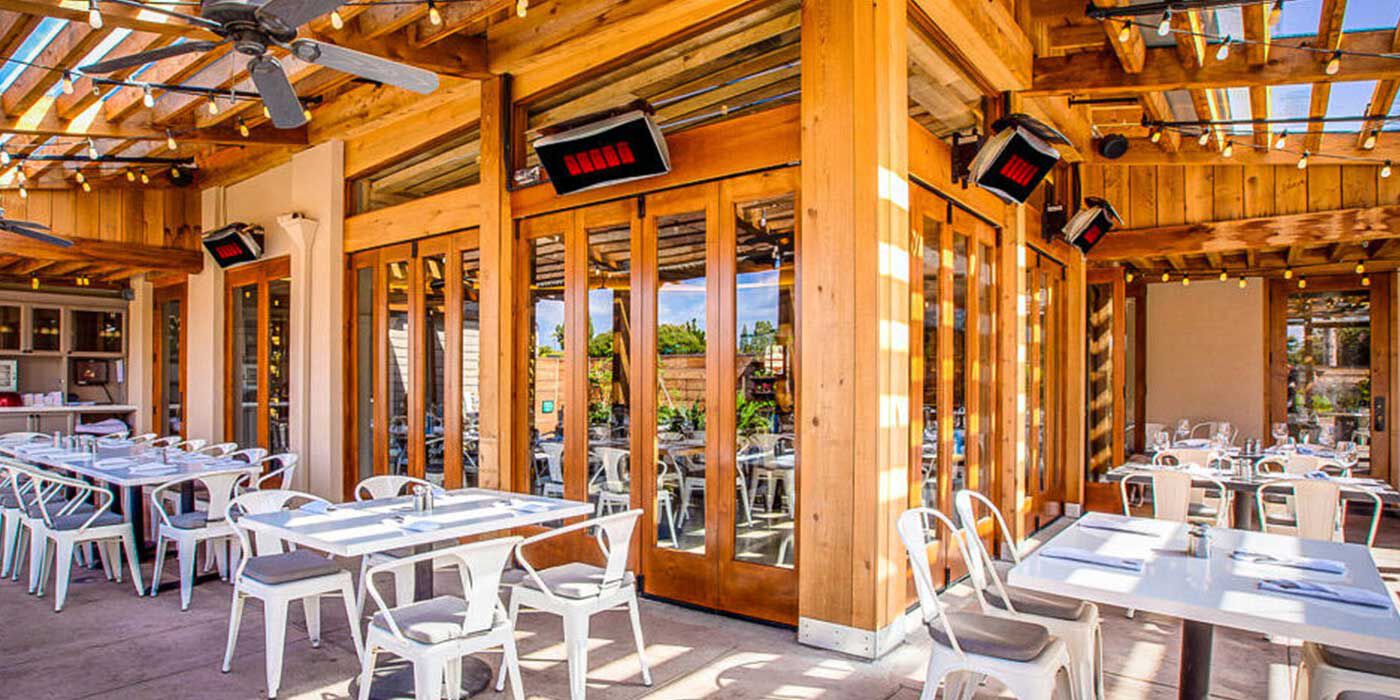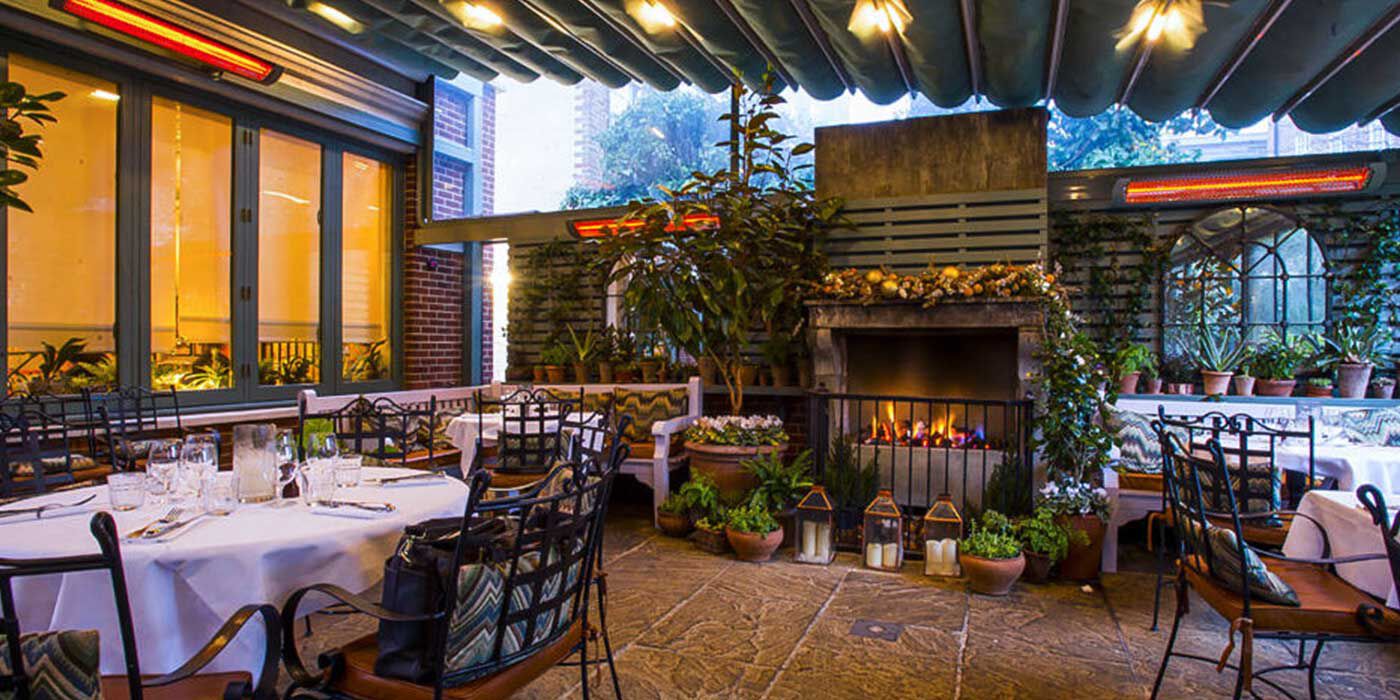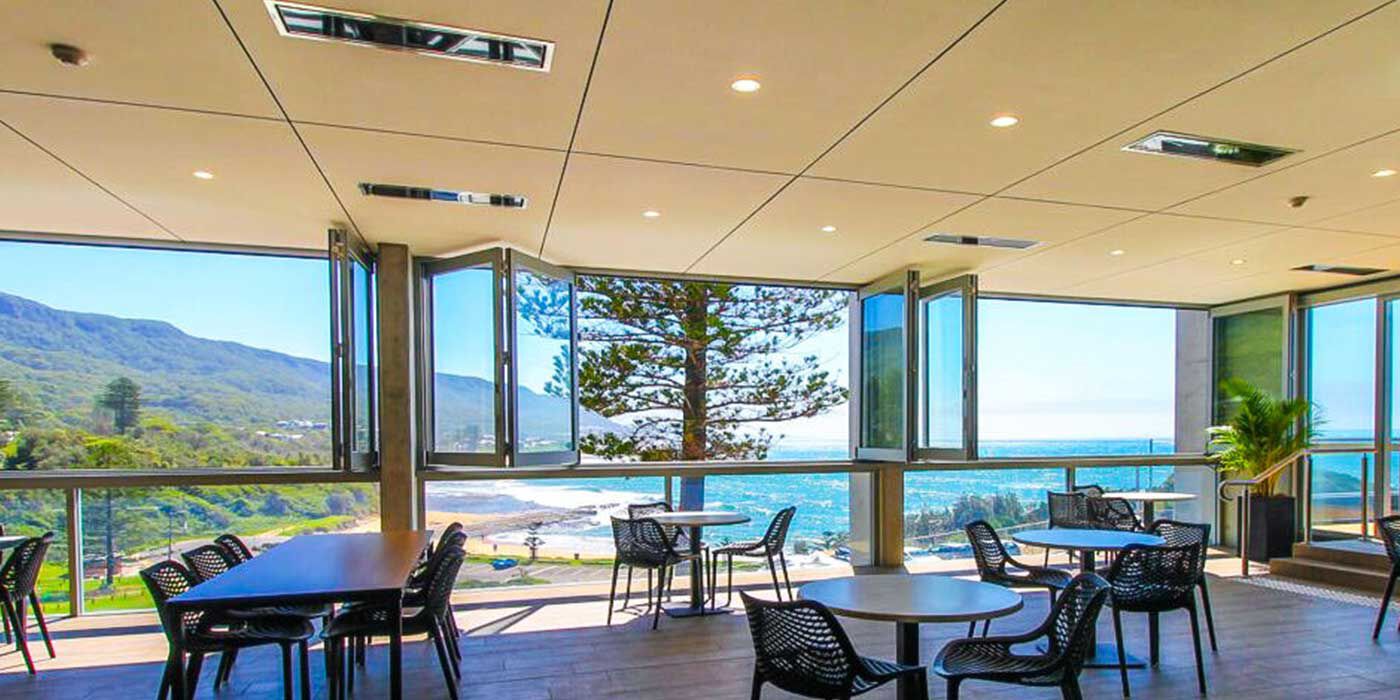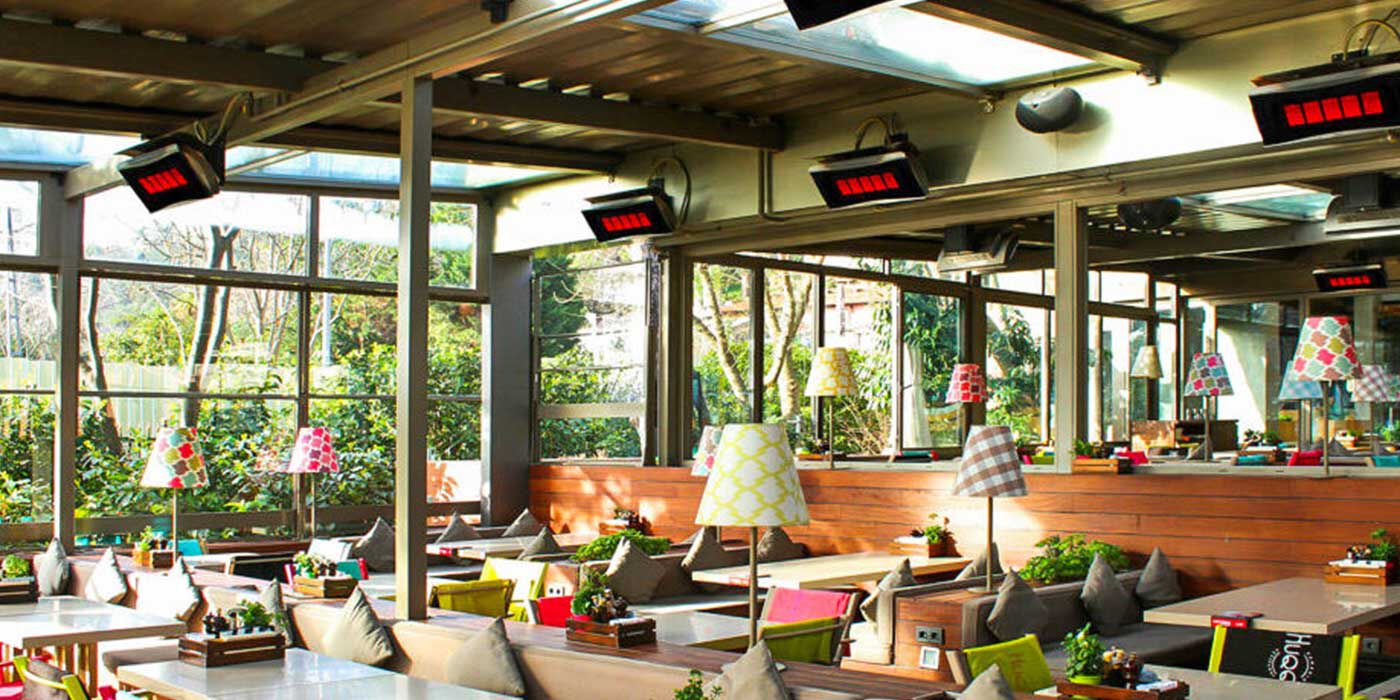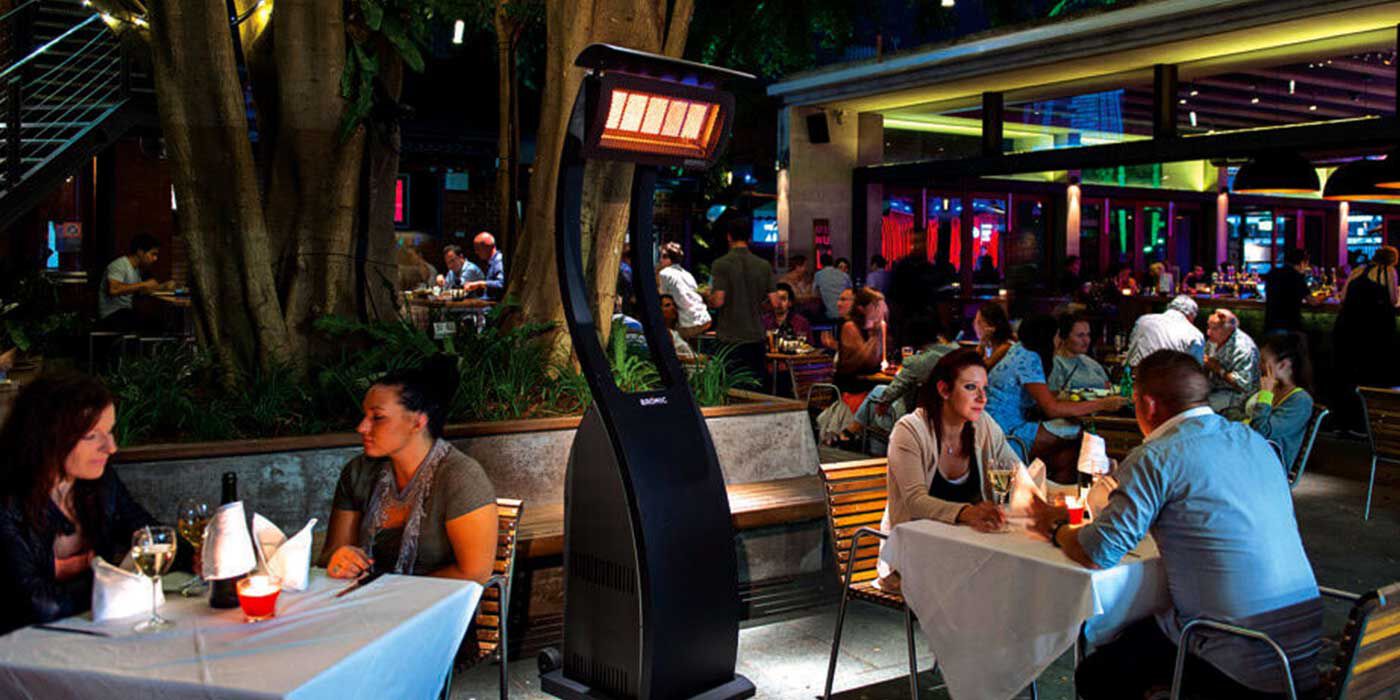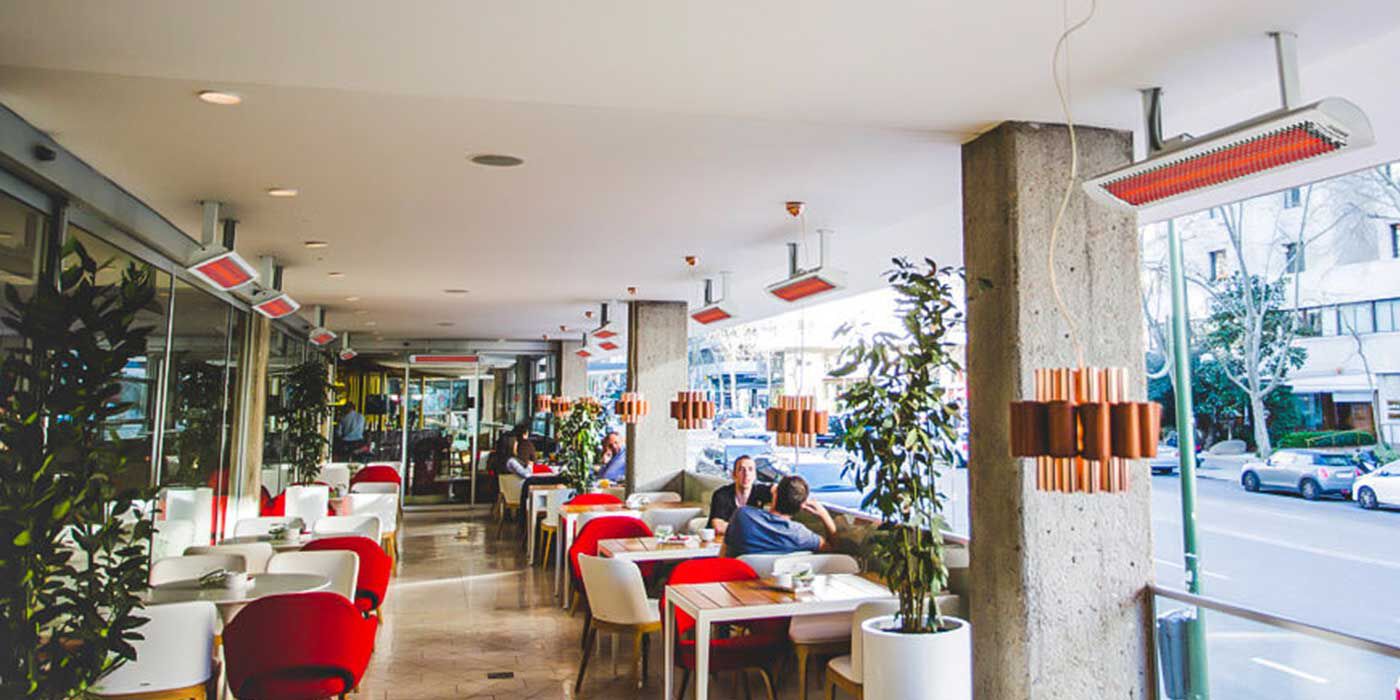By: Nick Janco, NFI Certified Master Hearth Professional
Last Updated: October 17, 2024
If you own a restaurant, hotel, bar, or retail space, you know comfortable outdoor seating is a valuable amenity for most patrons.
Creating an outdoor space that your customers can enjoy year-round, even through the colder months, boosts your reputation, leads to repeat visits, and encourages raving reviews. It's an effective way to stand out from your competition, especially if you live in an area with a lot of local hot-spots.
Adding patio heaters is an simple, affordable, and efficient way to keep your outdoor space open for business in any season. With a variety of stylish, hassle-free designs to choose from, it's easy to find the perfect solution for every setting.
Patio Heater Benefits
Patio heaters are very low-maintenance. They can be installed safely indoors and outdoors, depending on the fuel type. They're also available in a wide range of styles to fit every space and heating need.
They're safer and easier to integrate into your space than other fire products, like fireplaces and gas fire pits.
Patio heaters are designed to produce waves of energy, called radiant heat, which warms solid objects and people rather than the air.
All the heat produced stays put and won’t get carried away by the wind, making patio heaters an excellent way to optimize the use of your outdoor space.
What Kind of Businesses Use Patio Heaters & Where Can They Be Installed?
Restaurants, hotels, bars, coffee shops, retail shops, and any public loitering spaces can benefit from the addition of patio heaters.
Hotels and resorts can put patio heaters in the main entrance, by the valet, check-in area or lobby, courtyard, patio, terrace, and along outdoor walkways.
Patio heaters can also be combined with a fire pit or fireplace in outdoor seating areas to maximize heat, ambiance, and comfort of your guests.
Retail shops can install patio heaters in entrances and vestibules to provide warmth for customers who may be waiting for their turn to shop in your store.
For restaurants, bars, and coffee shops, patio heaters work best in waiting areas, like the entrance, vestibule, valet, and along the outside of the building where patrons might be standing in line, as well as outdoor seating areas like covered and open-air patios, rooftops, and terraces.
How Will Patio Heaters Add Value to My Business?
Increased Capacity: Outdoor seating expands your available space, so you can serve more customers. This is especially beneficial during busy seasons, when indoor space is limited.
Customer Preference: Some customers prefer outdoor dining, even in the winter. They may enjoy the fresh air or feel safer in an open environment, particularly during flu season.
Unique Atmosphere: Outdoor seating can create a cozy and unique atmosphere with the right winter decor, heating solutions, and lighting. This can attract customers looking for a one-of-a-kind dining experience, making your business stand out from competitors.
Extended Revenue: By offering outdoor seating year-round, your business can maintain or even increase revenue during the colder months, instead of experiencing a drop when outdoor spaces would typically close.
Brand Image and Marketing: A well-designed and heated outdoor area can enhance your brand image, making it a talking point and drawing in customers through word-of-mouth or social media.
Adaptation to Trends: Outdoor dining has become more popular and expected in many places, especially in urban areas. Offering it year-round shows that your business is adaptable and responsive to customer trends.
Regulations and Restrictions: In some areas, indoor seating might be limited due to health regulations, so outdoor seating provides a way to continue serving customers, while adhering to restrictions.
What Kind of Patio Heaters are Available?
Commercial patio heaters are available in free-standing, pole-mounted, and wall and ceiling-mounted models, allowing you to choose the style that best fits your business.
Wall and ceiling-mounted heaters are installed using adjustable brackets, making it easy to move the heaters up or down to find the perfect position. Zero-clearance ceiling-mounted heaters can also be recessed into the ceiling for a flush finish, creating a streamlined look.
You can group mounted patio heaters together into individual heating zones, which enables you to control each zone independently and ensures you’re only heating the space where patrons are gathered at any given time.
Free-standing heaters are great for open-air patios where heating may need to be adjusted on a day-to-day or even hour-to-hour basis. A Propane tank fits inside the base, so you can easily move freestanding heaters around and reconfigure their positioning at any time.
Both free-standing and mounted patio heaters should be spaced according to how much coverage you want and where your patrons will be located.
Since patio heaters are designed to heat people and objects, you’ll want to position them so that they are directed at the most common places your patrons will be standing or sitting.
What are the Requirements to Add Patio Heaters to a Commercial Space?
First, you’ll need to find out what type of fuel source you have access to — Natural Gas, Propane, or electricity. This will help narrow down the style and type of patio heater you can choose.
Pro Tip:
Gas heaters generate more heat than electric models, but the heat output isn’t adjustable, and control options are limited. Propane is usually the most expensive fuel source, and Natural gas is typically the cheapest.
Gas Patio Heaters
If gas will be your fuel source, you have the choice between free-standing heaters and wall, ceiling, or pole-mounted heaters. Free-standing heaters are fueled by individual Propane tanks, which get stored in the base of the heaters. For mounted styles, gas will need to be hard-piped to the heaters.
Gas heaters produce emissions and require ventilation. They cannot be installed in enclosed spaces or near combustible surfaces. Portable or free-standing heaters should not be installed in high-wind areas, as they can tip over and cause unnecessary injury, damage, or a fire.
Learn more about Natural Gas and Propane patio heaters.
Electric Patio Heaters
If electricity will be your fuel source, you have the choice of wall or ceiling-mounted heaters, which can be hung by brackets or recessed into the ceiling.
Electric patio heaters produce no carbon emissions and can be safely installed indoors, making them the most popular choice for commercial installations.
Some offer flushed/recessed installation, which means they can be installed in combustible surfaces and near combustible materials (check the owner’s manual first) and offer you the option to add adjustable heat settings.
Most commercial patio heaters run on 240-volts and will need to be professionally installed by a licensed electrician.
Some electric heaters can be plugged into a standard 120-volt wall socket, but they aren’t generally recommended for commercial use since they aren’t as powerful as 240-volt units.
Learn more about electric patio heaters.
Next, you’ll need to look at the square footage of your space and determine how much coverage you want and where the heaters will be located.
Patio heaters will increase the temperature by about 5-10 degrees, on average, and create a cone-shaped area of heat that can reach up to 370 square feet, depending on the size of the heater.
Spacing your patio heaters out so that the cones of heat overlap will help you achieve the optimal temperature and ensure you create a comfortable environment for your guests to enjoy.
Understanding the square footage you have available will ultimately determine which kind of heater you can choose and how many you can have in your space.
Our team of NFI certified Master Hearth Professionals offers a free design service that will help you create the perfect heating plan for your unique space. Call to work with one of our highly-trained experts at (800) 919-1904 today.
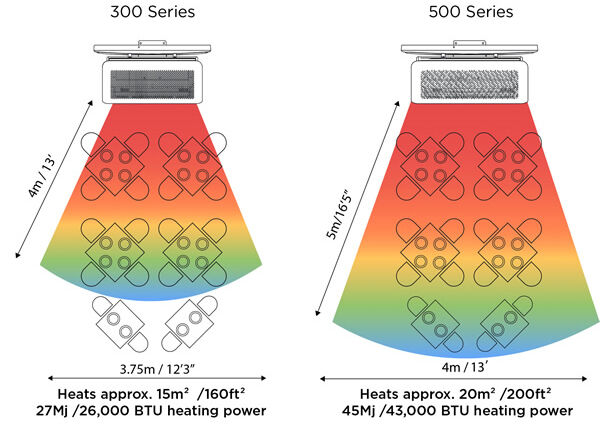
Finally, you’ll need to check your local building codes and restrictions, then check your clearance to combustibles.
You’ll need to make sure you have enough clearance from each heater to the wall, ceiling, and any other combustible materials that are nearby. Clearance requirements will be located in the user manual for each model of heater.
Patio Heater Controls
Gas heaters generally feature an On/Off control, like a wall switch or remote, while electric patio heaters offer a wider variety of control options, including On/Off switches, variable controls with timers and dimmers, master remotes, and wireless capability.
Electric heaters can be grouped together to create heating zones, giving you the ability to adjust the heat output from one or more heaters in a designated area. Bromic gas patio heaters are equipped with electronic ignition systems and can also be grouped into heating zones.
Most control options are brand-specific, so you'll want to look over each brand’s offering to determine which will work best for you.
Pro Tip:
Zone control systems can be set up so that one zone heats one individual table (one zone per table) and is controlled by the patron.
Quick Recap
- Patio heaters are a relatively small investment that will provide a considerable ROI for your business, and plenty of comfort for your guests, for many years to come.
- Patio heaters are suitable for indoor and outdoor installations, depending on fuel-type.
- Hotels, resorts, restaurants, bars, coffee shops, retail spaces, and public loitering areas all benefit from the addition of patio heaters.
- You have the choice between free-standing, wall-mounted, pole-mounted, and ceiling-mounted heaters.
- Determine your fuel source (Natural Gas, Propane, or electricity) to narrow down style options, measure the square footage you’re heating, and decide how many heaters you’ll need.
- Check local building codes and restrictions and clearance to combustibles.
- Choose the best patio heater model that fits your requirements and pick out your control options.
Prefer to Listen?
We're Here to Help
Call our NFI certified experts at (800) 919-1904 to create your heating plan today and start growing the profitable business you’ve been dreaming of!
More Resources
Head over to our Patio Heater Buying Guide to learn even more about patio heaters.
Read our breakdown on Gas vs. Electric Patio Heaters to find out which one is right for you.
Check out our Patio Heater FAQ page for answers to the top 10 most frequently asked patio heater questions.
 |
Nick Janco is a seasoned Technical Sales Representative with a decade of experience at Woodland Direct. As an NFI-Certified Master Hearth Professional, Nick is dedicated to helping his clients seamlessly integrate fire features into their homes, ensuring every detail is perfectly executed. While he's trained to assist with any fire-related project, Nick specializes in patio heaters. He's helped thousands of satisfied clients find the best heating solutions, offering valuable design, safety, and installation advice. Outside of work, Nick often spends time on the green enjoying a round of golf with his 5-year-old son. Call Nick or one of our experts in fire at 800.919.1904. |

